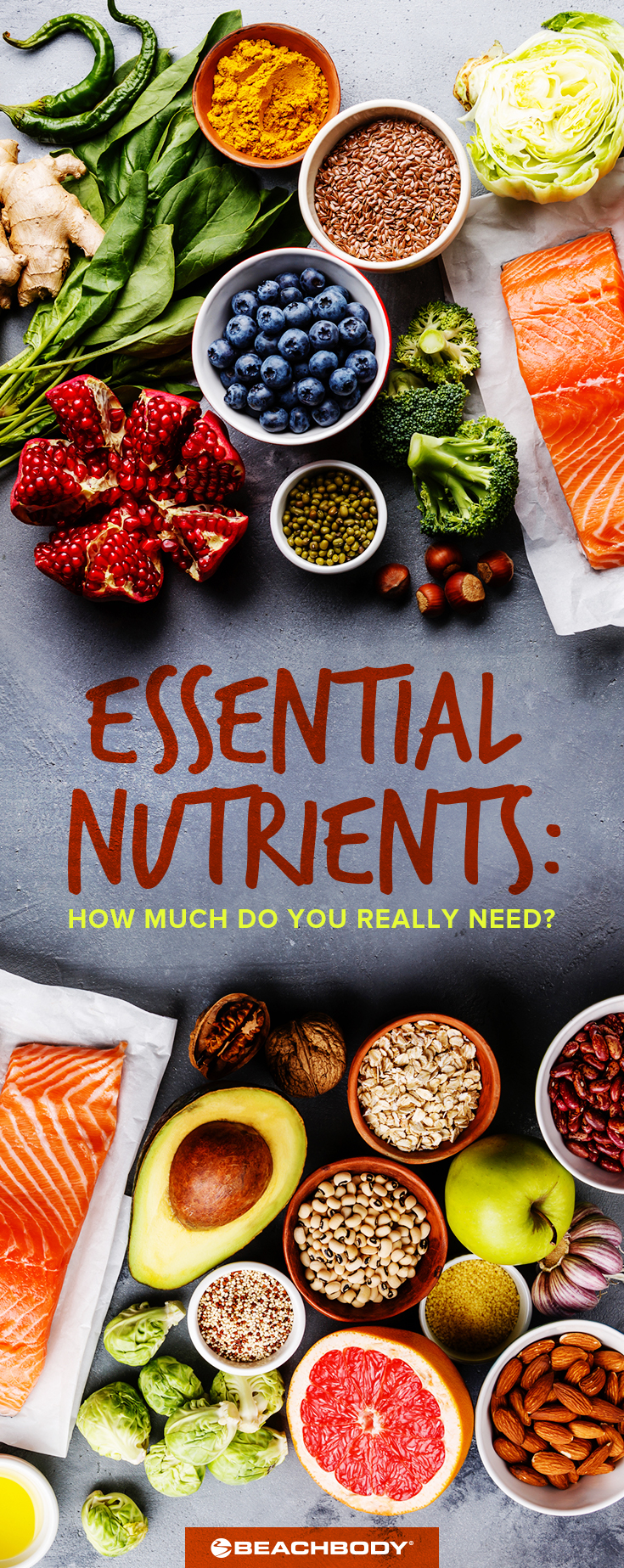Essential Nutrients: How Much Do You Really Need?
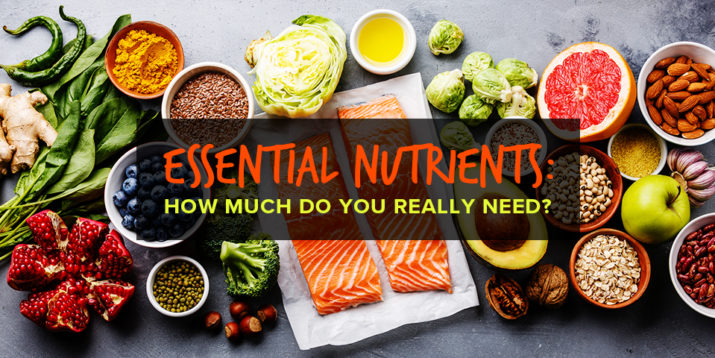
Protein | Fats | Carbohydrates | Vitamins | Minerals | Water | DRIs Explained
Food marketing does a great job of informing us when a product offers essential nutrients, but not a whole to inform us what that term actually means. It isn’t merely hype: essential nutrients are just that — only, the definition of “essential” when it comes to nutrition is a lot different from its use in describing oils and greatest hits collections.
There are dozens and hundreds of nutrients, but it doesn’t all have to be overwhelming. Read further to learn how essential nutrients earned the name, which nutrients qualify, and how to get more of them in your diet.
Why Are They Called “Essential Nutrients”?
While you might consider chocolate or avocado an essential nutrient, the word “essential” has a specific meaning when it comes to nutrition — one that’s not quite as subjective.
If a nutrient is “essential,” that means that your body needs it but can’t produce it on its own.
“Essential nutrients cannot be synthesized by the body so they need to be consumed through food or dietary supplements,” says Krista Maguire, R.D. and senior nutrition manager at BODi.
But no single food provides all the vitamins and minerals we need, which is why it’s important to eat a diverse, healthy, nutrient-dense diet.
What Are the 6 Essential Nutrients?
“There are nine essential amino acids (proteins), two fatty acids (omega-6 and omega-3 polyunsaturated fats), 13 vitamins, and 20 minerals, plus water and glucose (a carb) that are considered ‘essential,'” Maguire says.
Here’s a full breakdown of all 47 of them:
1. Protein (essential amino acids)
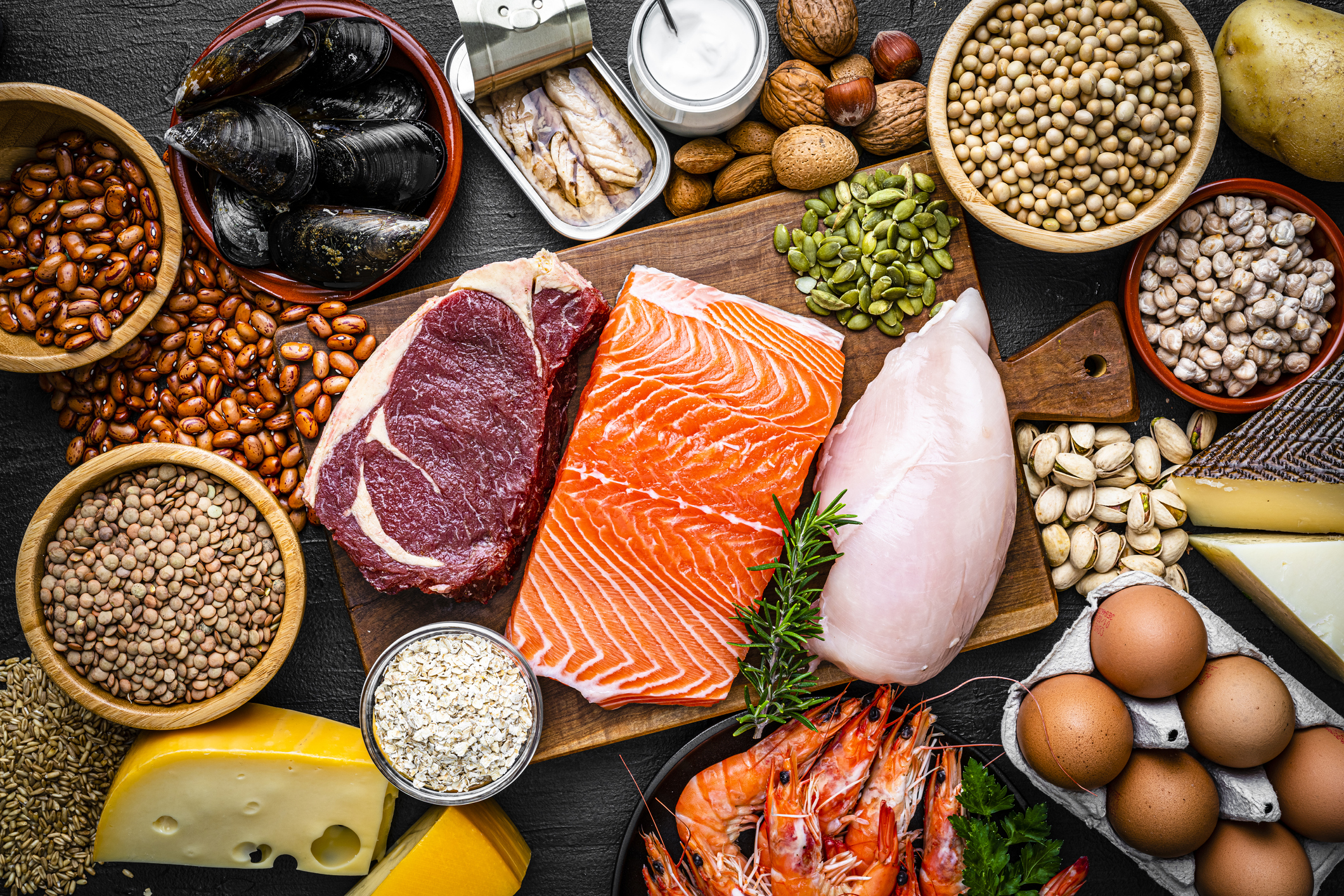
| Histidine | Isoleucine | Leucine |
| Lysine | Methionine | Phenylalanine |
| Threonine | Tryptophan | Valine |
Essential amino acids are often described as the building blocks of protein and are likely the most familiar group of essential nutrients.
“The term ‘essential nutrients’ isn’t used as often, but we often hear of ‘essential amino acids,’” Maguire says.
Protein-rich foods provide amino acids and, while your body can produce some of the 20 different aminos it needs, nine of them are essential because (you guessed it) you can’t make them.
What do amino acids do?
Your body needs these amino acids to form enzymes, which are proteins that help us break down and digest food, repair body tissues (such as after a hard workout), and grow and develop normally, among other bodily functions.
Sources of amino acids
Rather than focusing on individual amino acids, your emphasis should be on eating a diverse healthy diet.
“We don’t need to pay too close attention to individual amino acids,” says Maguire. Instead, she recommends focusing on the variety and quality of your protein sources.
For example, most plant proteins are not considered “complete,” because “they are usually lacking in one or more of the essential amino acids,” Maguire says.
She cites that legumes, lentils, and beans are low in methionine and higher in lysine, while grains, nuts, and seeds are low in lysine and high in methionine and threonine.
Confused? Don’t sweat it.
“Dishes usually combine the two naturally so that it makes a ‘complete’ protein without thinking about it — think beans and rice!” she adds.
Maguire says that animal-based proteins usually have a more favorable protein digestibility-corrected amino acid score. “This measure is based on protein absorption and utilization as well as amino acid content,” she explains.
While whey is a 1, the highest score, beans and legumes come in at a 0.6.
“However, this doesn’t mean that you can’t achieve quality protein intake on vegetable-based proteins,” she says. “It’s just important to vary your diet to ensure you’re meeting your needs.”
How much protein do you need?
The Dietary Reference Intakes for protein are 56 g for men ages 19-70 and 46 g for women ages 19-70. BODi nutrition plans recommend that 30 percent of your daily calories come from protein.
The recommendations differ because that first amount is the RDA, or the minimum amount you need to stay healthy — and that RDA doesn’t take into account your health and fitness goals.
Click here for more on optimal protein intake.
2. Fats (essential fatty acids)

- Omega-6 (linoleic acid) polyunsaturated fat
- Omega-3 (alpha-linolenic acid) polyunsaturated fat
The essential fatty acids are the omega-6 fatty acid linoleic acid and the omega-3 fatty acid alpha-linolenic acid, both of which are polyunsaturated fats.
Omega-6 fatty acids are common in the standard American diet, so most people get enough of this essential fat.
By contrast, Omega-3 fatty acids are not as common, and these are a type of fat that has received quite a bit of attention in recent years.
What do fatty acids do?
Fat plays crucial roles in maintaining our health. It’s used in the body for cell insulation and structure, nerve transmission, hormone production, and the absorption of certain vitamins.
Studies show that omega-3s may also support heart health. Fats help keep our skin and hair healthy, too.
Omega fatty acids sources
Omega-6 fatty acids are found in common cooking oils like sunflower, safflower, soy, canola, and corn oils, among others. However, the refining processes of these oils can cause oxidation of the polyunsaturated fats, making them unhealthy.
Therefore, it’s best to avoid omega 6-rich oils and instead eat the raw nuts and seeds from which they’re extracted. That’s because, in the whole foods, the quality of the essential fatty acids is better preserved and of greater benefit.
Omega-3s are found in fatty fish (like salmon), some vegetable oils, nuts, flax seed, and even leafy greens (in smaller amounts).
There are three types of omega-3s: eicosapentaenoic acid (EPA), docosahexaenoic acid (DHA), and alpha-linolenic acid (ALA).
EPA and DHA are the ones that come primarily from fish; ALA, which is the most common omega-3 in our diet, comes mostly from plant foods.
How much fat do you need?
While there are no established RDAs for omega-3 or omega-6 fatty acids, there are established Adequate Intakes for both: From ages 19-50, men need 17 grams of linoleic acid. After age 50, they need 14 grams. Women need 12 grams from ages 19-50 and 11 grams after that. With alpha-linolenic acid, women need 1.1 grams from 19-70 and older; men need 1.6 grams.
3. Carbohydrates
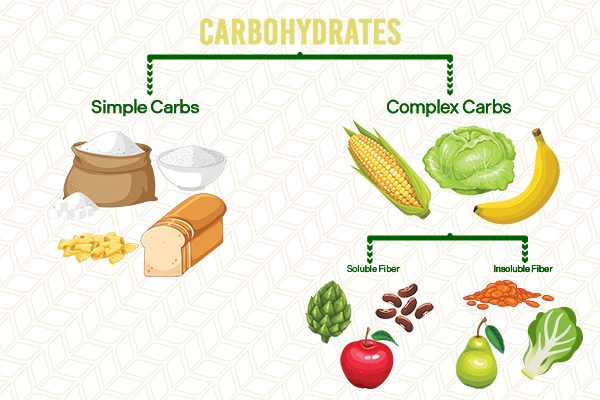
Carbs have come under attack in recent years, but they are your body’s preferred source of energy. Along with fat and protein, carbohydrates are among the three macronutrients that provide you with the calories you need each day.
Consisting of carbon, hydrogen, and oxygen, carbohydrates are often referred to as sugars or starches. These sugars, also known as saccharides, vary from simple to complex, depending on the chain length of their molecular structures.
Simple sugars are most often refined in a process that extracts from whole foods the starches that become products like white flour and white rice, and sweeteners like honey, maple syrup, and white sugar. These short-chain sugars burn quickly, are low in fiber and nutrients, and can be high in added sugar.
Complex carbs, conversely, comprise longer-chain sugars, and are the more preferable of the two. Often counted among these complex carbs is fiber, which is also split into two types: soluble and insoluble.
What do carbs do?
Carbohydrates provide the readiest source of energy for the body, and can aid the digestive process, depending on their type.
Simple carbs provide quick energy, which can be helpful during periods of intense physical activity, but can be stored in excess if not burned. That can lead to weight gain and even negative effects on blood sugar and heart health.
Complex carbohydrates usually contain vitamins, minerals, and phytonutrients, and take longer to digest, which allows for a slower, more gradual release of energy. They’re also the only source of both soluble and insoluble fiber.
Soluble fiber forms a gel-like substance in the body that slows digestion and may help maintain healthy blood glucose levels. Equally important, insoluble fiber adds bulk to digested food in order to help facilitate movement through the gastrointestinal tract.
Healthy carbohydrate sources: Complex carbs are found in whole grains, fruits, legumes, and starchy vegetables, while simple carbs are typically consumed in sugary baked goods, soft drinks, and sweeteners.
That means favoring whole strawberries over strawberry jam, corn over corn syrup, and whole flour over its bleached counterpart. Almost any whole, plant-based food will suffice.
How many carbs per day do you need? The most recent Dietary Guidelines for Americans recommend that 45 to 65 percent of your total calorie intake come from carbohydrate.
BODi’s Portion Fix nutrition program specifies a balance of roughly 40 percent carbohydrates and 30 percent each of protein and fat. This breakdown can be helpful for either weight loss or maintaining your current healthy lifestyle.
4. Essential vitamins
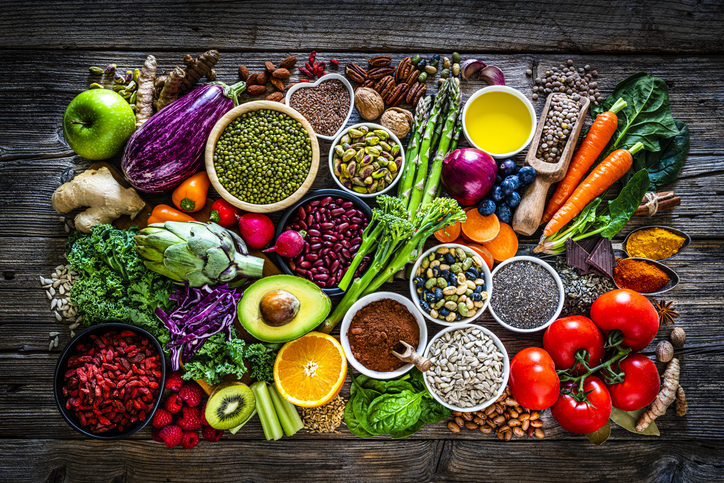
Vitamins and minerals are considered micronutrients (not to be confused with the macronutrients: fat, carbs, and protein).
Vitamins are subdivided into two categories: water-soluble (this group includes the B vitamins and vitamin C) and fat-soluble (vitamins A, D, E, and K).
Vitamin A
- What does vitamin A do? Vitamin A plays many roles, including bone and tooth growth, support for the immune system, and growing and maintaining healthy skin, hair, and mucous membranes.
- Vitamin A sources: Beef liver, yellow and orange fruits and veggies, leafy greens, and fortified dairy.
- How much vitamin A per day for a man: 900 mcg
- How much vitamin A per day for a women: 700 mcg
Vitamin D
- What does vitamin D do? Among the functions vitamin D helps facilitate are: bone and teeth growth, and helping support cardiovascular health and the nervous system.
- Vitamin D sources: Fatty fish, beef liver, egg yolks, cheese, mushrooms, and cheese, fortified foods (such as cereals and orange juice). It is also synthesized in the body following exposure of the skin to sunlight (mimicked in supplement form as vitamin D3, or cholecalciferol).
- How much vitamin D per day: 600 IUs for men and women
Vitamin E
- What does vitamin E do? Supports the circulatory system, cell communication, and immune system, among other functions.
- Vitamin E sources: Wheat germ oil, nuts, leafy greens, vegetable oils, and fortified cereals.
- How much vitamin E per day: 15 mg (22.4 IU of natural form and 33.3 IU of synthetic form)
Vitamin K
- What does vitamin K do? Supports the circulatory system and promotes healthy bones. It is found in two forms: K1 and K2, the latter being the active form.
- Vitamin K1 is found in: Leafy greens, fruit, and grains
- Vitamin K2 is found in: Fermented foods (such as yellow cheese and natto), liver, chicken, egg yolks, and butter. K2 is also converted from K1 in the large intestine by bacteria, which feed on fiber.
- How much vitamin K per day: 120 mcg for men | 90 mcg for women
Vitamin C
- What does vitamin C do? Supports the structure of bones, cartilage, blood vessels, and muscle; is necessary for collagen production, is an important antioxidant, and supports the immune system.
- Vitamin C sources: Citrus fruits, berries, and vegetables (particularly peppers).
- How much vitamin C per day: 90 mg for men | 75 mg for women
Vitamin B1 (thiamin)
- What does vitamin B1 do? Supports the growth and development of cells, as well as cell function; it also helps the body release energy from carbs.
- Vitamin B1 sources: Meat, liver, whole grains, and fortified cereals.
- How much B1 per day: 1.2 mg for men | 1.1 mg for women
Vitamin B2 (riboflavin)
- What does vitamin B2 do? Helps the body release energy from macronutrients.
- Vitamin B2 sources: Whole grains, leafy greens, organ meats, eggs, and milk.
- Vitamin B2 dosage per day: 1.3 mg for men | 1.1 mg for women
Vitamin B3 (niacin)
- What does vitamin B3 do? Supports macronutrient metabolism.
- Vitamin B3 sources: Meat, poultry, and fish, and fortified cereals, dairy, and eggs.
- How much niacin per day: 16 mg for men | 14 mg for women
Pantothenic acid (B5)
- What does pantothenic acid do? Helps the body release energy from fats and vegetables.
- Pantothenic acid sources: Animal proteins, avocado, cruciferous vegetables, eggs, legumes, and milk.
- How much pantothenic acid per day: 5 mg for men and women aged 14 and older
Biotin (B7)
- What does biotin do? Aids the metabolism of macronutrients.
- Biotin sources: Cereals, egg yolk, legumes, milk, nuts, and organ meats.
- How much biotin per day? 30 mcg for adults age 19 and older
Vitamin B6
- What does vitamin B6 do? Aids in protein metabolism and is crucial to more than 100 metabolic enzyme reactions.
- Vitamin B6 sources: Fish, poultry, meat, bananas, whole grains, and avocados.
- How much vitamin B6 per day for men: 1.3 mg for ages 19-50, 1.7 mg for ages 51 and older
- How much vitamin B6 per day for women: 1.3 mg for ages 19-50, 1.5 mg for ages 51 and older
Vitamin B12 (cyanocobalamin)
- What does vitamin B12 do? Aids in cell development (especially of nerve and blood cells). Vitamin B12 also supports nervous system function and metabolism of protein and fat.
- Vitamin B12 sources: Meats, milk, and seafood.
- How much B12 per day: 2.4 mcg for men and women aged 14 and older
Folate (folic acid and B9)
- What does folate do? Folate/folic acid/B9 helps with development of genetic material like DNA, and supports production of red blood cells.
- Folate sources: Beef liver, pulses, leafy greens, and nuts.
- How much folate per day: 400 mcg for men and women aged 14 and older
5. Essential minerals
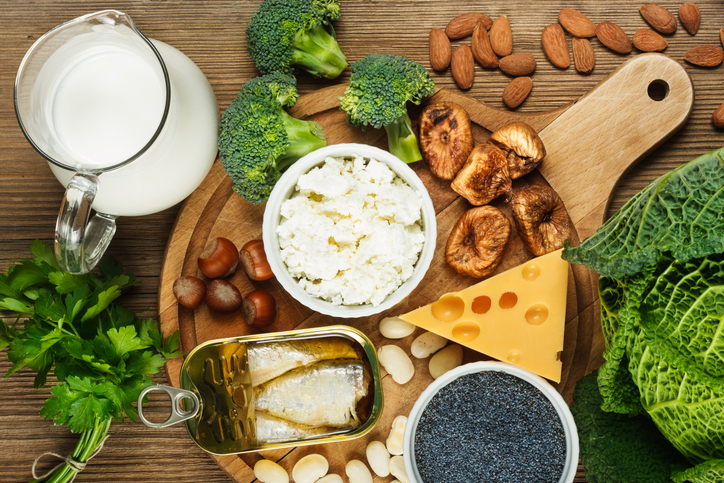
| Bromine | Calcium | Chloride | Chromium | Cobalt |
| Copper | Fluoride | Iodine | Iron | Magnesium |
| Manganese | Molybdenum | Phosphorus | Potassium | Selenium |
| Silicon | Sodium | Sulfur | Vanadium | Zinc |
Like vitamins, minerals are subdivided. The two groups of minerals are macrominerals or major minerals (calcium, phosphorus, magnesium, sodium, sulfur, chloride, and potassium) and microminerals or trace minerals (like iron, iodine, selenium, and zinc).
Macrominerals are essential in amounts of 100 milligrams or higher each day; trace minerals are found in small amounts in the body.
The following are minerals that have established RDAs or AIs.
Calcium
- What does calcium do? Promotes strong bones and teeth. Calcium also aids muscle movement and helps with transporting messages from the brain to other body parts.
- Calcium sources: Milk, fortified dairy-free milk alternatives, leafy greens, and calcium-set tofu.
- How much calcium per day for men: 1,000 mg for ages 19-70, 1,200 mg for ages 70 and older
- How much calcium per day for women: 1,000 mg for ages 19-50, 1,200 mg for ages 51 and older
Chloride
- What does chloride do? Helps maintain balance of bodily fluids, and is an important part of digestive fluids.
- Chloride sources: Salt, sea vegetables, lettuce, celery, and rye.
- How much chloride per day: Adequate intakes for the following ages are as follows:
- Ages 14-50: 2,300 mg daily
- Ages 51-70: 2,000 mg daily
- Ages 71 and older: 1,800 mg daily
Chromium
- What does chromium do? Supports glucose metabolism.
- Chromium sources: Brewer’s yeast, whole-grain cereals, and clams.
- How much chromium per day for men: 35 mcg for ages 19-50, 30 mcg for ages 50 and older
- How much chromium per day for women: 25 mcg for ages 19-50, 20 mcg for ages 50 and older
Copper
- What does copper do? Supports red blood cell production, bone growth, immune system health, blood vessels, and nerves.
- Copper sources: Shellfish, whole grains, beans, nut, potatoes, and organ meats.
- How much copper per day: 900 mcg for adults age 19 and older
Fluoride
- What does fluoride do? Supports bone formation and dental health.
- Fluoride sources: Fluoridated water, tea, and ocean fish.
- How much fluoride for men: adequate intake is 4 mg
- How much fluoride for women: adequate intake is 3 mg
Iodine
- What does iodine do? Supports production of thyroid hormones.
- Iodine sources: Seafood and iodized salt.
- How much iodine per day: 150 mcg for men and women age 14 and older
Iron
- What does iron do? Supports hemoglobin production and the immune system.
- Iron sources: Seafood, meat, and poultry, fortified cereals, pulses (white beans, kidney beans, and peas), spinach, tofu, and nuts.
- How much iron per day for men: 8 mg
- How much iron per day for women: 18 mg for ages 19-50, 8 mg for ages 51 and older
Magnesium
- What does magnesium do? Magnesium supports bone formation, muscle and nerve function, and the cardiovascular system.
- Magnesium sources: Pulses, nuts, whole grains, and leafy greens.
- How much magnesium per day for men: 400 mg for ages 19-30, 420 mg for ages 31 and older
- How much magnesium per day for women: 310 mg for ages 19-30, 320 mg for ages 31 and older
Manganese
- What does manganese do? Supports bone formation and macronutrient metabolism.
- Manganese sources: Fruits, vegetables, nuts, and whole grains.
- How much manganese per day for men: adequate intake is 2.3 mg
- How much manganese per day for women: adequate intake is 1.8 mg
Molybdenum
- What does molybdenum do? Molybdenum is a co-factor for certain enzymes.
- Molybdenum sources: Legumes, grains, and nuts.
- How much molybdenum per day: 45 mcg
Phosphorus
- What does phosphorus do? Aids in bone development and filtering waste from kidneys.
- Phosphorus sources: Fish, meat, poultry, eggs, and grains.
- How much phosphorus per day: 700 mg
Potassium
- What does potassium do? Aids in fluid balance, and helps with controlling activity of the heart, muscles, nervous system, and kidneys.
- Potassium sources: Fruits, vegetables, and meat.
- How much potassium per day: adequate intake is 4,700 mg.
Selenium
- What does selenium do? Helps with thyroid function, antioxidant support, and DNA production.
- Selenium sources: Brazil nuts, seafood, lean meats, and grains.
- How much selenium per day: 55 mcg for men and women age 14 and older
Sodium
- What does sodium do? Helps control fluid levels, and both nerve and muscle function.
- Sodium sources: Salt, as well as milk, beets, and celery.
- Sodium per day: For most people, high salt intake is linked to high blood pressure, so it’s wise to consume no more 2,300 mg.
Zinc
- What does zinc do? Supports healing and the immune system and protein and DNA production.
- Zinc sources: Meat, liver, eggs, seafood, and whole grains.
- How much zinc per day for men: 11 mg
- How much zinc per day for women: 8 mg
6. Water

No surprise here: Water is essential. The adequate intake is 2.7 liters a day for women ages 19 to 70 and over, while men need 3.7 liters.
That’s about 91 ounces for women, and 125 ounces for men, but keep in mind that some water will come from your food, too.
(That’s slightly higher than the formula BODi uses, which is to divide your body weight by two and drink that many ounces a day, so make sure you’re getting at least as much as the body weight formula tells you to consume.)
Types of Dietary Reference Intakes (DRIs)
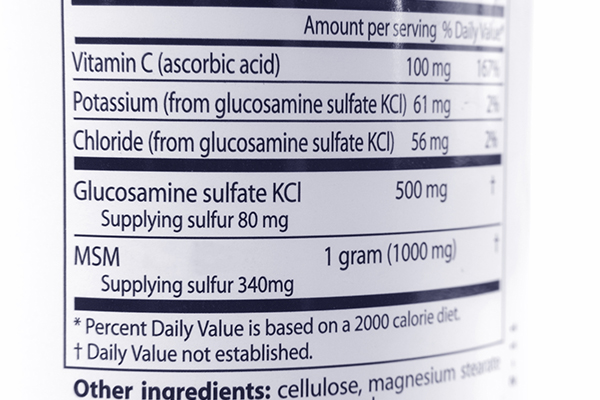
Ever take a close look at the Nutrition Facts or Supplements Facts label? If so, you might see one or more acronyms listed alongside a number.
What is the difference between those measurements? And, when it comes to essential nutrients, which numbers matter most?
These various acronyms are all types of Dietary Reference Intakes (DRIs).
These DRIs are quantitative estimates of nutrients used for planning and evaluating diets of healthy people, and they are determined by the Food and Nutrition Board of the Institute of Medicine, National Academy of Sciences.
Here’s a quick rundown from the Academy of Sciences:
- Recommended Dietary Allowance (RDA): Average daily dietary intake level sufficient to meet the nutrient requirement of 97 to 98 percent of healthy individuals in certain groups.
- Adequate Intake (AI): Based on “observed or experimentally determined approximations of nutrient intake” by groups of healthy people. This is used when an RDA cannot be determined.
- Tolerable Upper Intake Level (UL): This is the highest amount you can take in safely in a day that is likely to pose no risk of adverse health effects (to most individuals in a certain population group).
- Estimated Average Requirement (EAR): This value is estimated to meet the nutrient requirement of half of the healthy individuals in a group.
For the above essential nutrients, we’ve focused on RDAs (and AIs when the former isn’t available). However, depending on individual circumstances, some health professionals may recommend higher values.
The Bottom Line
Certain nutrients are considered essential because the body can’t make them on its own; we have to consume these fatty acids, amino acids, vitamins, and minerals from food.
Eating a balanced, healthy diet helps ensure we’re getting these essential nutrients, and if you’re concerned about your intake of a specific nutrient, track your food intake and talk to your doctor about testing your levels.
Pro tip: A daily Shakeology can be a good choice that provides protein, fats, vitamins, and minerals and can help you meet your daily nutrient needs.
